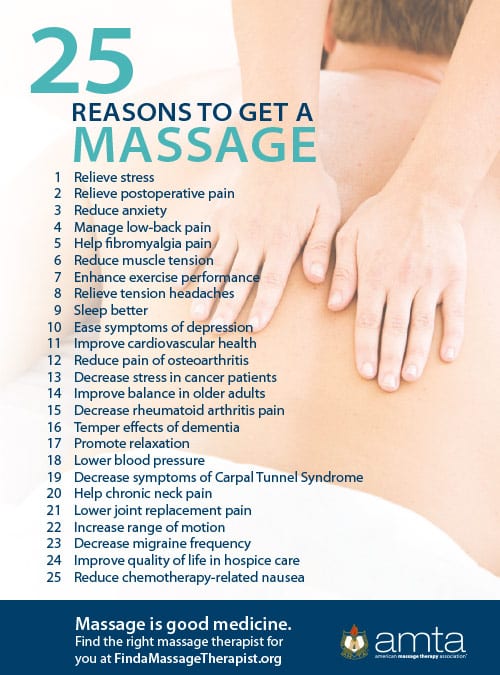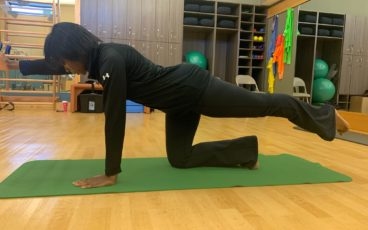To some, receiving a massage may be seen as a luxury, something that you only get for a special occasion. Not only do massages feel great, but they also offer a therapeutic value for pain management and can help speed up the healing process after an injury or surgery. If you are someone who takes an active role in health maintenance and injury prevention, massage therapy can be an integrative part of your health care.
Yvonne Gonzalez, Licensed Massage Therapist (LMT) at Illinois Bone & Joint Institute (IBJI), answers questions about massage therapy and when to incorporate it into your care plan.
Studies of the benefits of massage therapy indicate it is an effective treatment for reducing stress, pain, and muscle tension. The following are just a few of the many conditions that may be effectively treated:
- Anxiety and depression
- Digestive disorders
- Fibromyalgia
- Headaches
- Insomnia related to stress
- Myofascial pain syndrome
- Soft tissue strains or injuries
- Sports injuries
When should I incorporate massage into my care plan?
Massage may be integrated at various stages of care. There can be targeted treatment plans for relaxation, preventive/body maintenance, pre-/post-operative conditions, rehabilitation, or sports conditioning that determine the most effective protocols based on your needs and goals. The appropriate methods of treatment are determined by health history, chief concerns at the time of the massage therapy request and a consultation with the client/patient. When an injury is of concern, there is further consideration of treatment plan details. A review of your health history may also indicate a reason to withhold treatment.
How does massage therapy help to heal the body?
In general, massage therapy increases circulation, expedites healing processes, and reduces stress levels. Studies point toward the effectiveness of massage therapy, identifying the practice as a ‘natural pain reducer’ due to its release of endorphins — the body’s own natural pain relievers. It can also act as an anti-inflammatory.
According to published studies in The National Center for Biotechnology Information (NCBI), the positive effects of massage therapy on biochemistry, included decreased levels of cortisol and increased levels of serotonin and dopamine. These studies suggest the stress alleviating effects (decreased cortisol) and the activating effects (increased serotonin and dopamine) of massage therapy on a variety of medical conditions and stressful experiences, thus promoting the healing potential of one’s body.
How long after an injury do you need to wait to be cleared to get a massage?
This depends on the nature and severity of the injury, from strain and sprain to surgical procedures, as well as a person’s healing abilities. An initial goal is to reduce any fever and/or inflammation prior to massage. There is usually a recommended minimum of 2-3 weeks after surgery or injury. A specific goal in treating an injury or surgical incision is to focus on breaking up scar tissue and adhesions. Massaging scar tissue and using techniques like cross-fiber friction can boost the healing process. Massage therapy is not recommended for patients with any open wounds, burns, or infections. Consult with your physician for recommendation.
Are there treatment plans for massage?
Every client/patient session is personally determined by the needs and concerns indicated through medical history, observation, primary health concerns and consultation. Upon evaluation, a treatment plan is created which includes designated techniques, recommended protocols, and session follow up to meet designated goals.
How often should you include massage in your care plan?
Patients should consider massage therapy for general health maintenance that increases circulation to promote healing processes, stimulates healthy soft-tissue, and reduces stress. More frequent massage of up to 1-2 times per week, may be recommended where injury or surgical procedures are a focus of concern.
What is the intensity of the massage that is used in the care plan?
The protocols and techniques used within a treatment plan are all determined by each individual’s needs. For example, if a client/patient indicates concerns of stress and insomnia, a treatment plan may include more circulatory techniques, i.e. effleurage and petrissage, whereas, sore muscles and restricted range of motion may require deeper pressure techniques, along with assisted stretching. This can be achieved within a time frame of 1-2 times per month. For injury and surgical procedures, specific techniques are indicated to promote circulation and tissue healing. Clinical sessions can be as often as 1-2 times per week.
What does massage do for the body/an injury?
The American Massage Therapy Association indicates many benefits of massage therapy. The following highlight just a few of these benefits:
- Increases circulation to promote decrease in stress and healing of soft-tissue structures
- A variety of techniques help to restore and maintain body health by increasing cell repair
- Boosts immunity
- Supports mental health by reducing stress
- Improves sleep
- Reduces high blood pressure
- Helps to warm and loosen muscle and connective fibers, reducing strain on muscles and tendons
- Relieves tension and fatigue of muscle fibers
- Increases flexibility and joint movement by increasing range of motion, enhancing body performance and muscle fiber resiliency
- Improves muscle fatigue and recovery after physical workouts
- Deep tissue helps to flush out lactic acid and toxins
Yvonne Gonzalez is a Licensed Massage Therapist (LMT) at Illinois Bone & Joint Institute.

Yvonne Gonzalez, LMT
Licensed Massage Therapist

*This content is for information only and is not intended to replace the diagnosis, treatment, or medical advice from your treating healthcare professionals. The content does not provide medical advice, does not constitute the practice of medicine or other healthcare professional services, and does not create a doctor-patient relationship. You should not rely on this information as a substitute, nor does it replace professional medical advice, diagnosis, or treatment. If you have concerns or questions, seek the advice of your healthcare professionals. If you think you may have a medical emergency, call your doctor or 911 immediately. Do not rely on electronic communications or communicate through this website for immediate, urgent medical needs. This website is not designed to facilitate medical emergencies. The use of the information is at the reader’s own risk. The links are provided for information and convenience only. We cannot accept responsibility for the sites linked or the information found here. A link does not imply an endorsement of a site.


.jpg)

